Jack Daniel’s. Jim Beam. Johnnie Walker. Two bourbons and a scotch – on one hand opposite ends of the spectrum to a picky drinker, on the other, almost neighbors. However, to someone less familiar with whisky drinking, seeing such similar sounding names on a list can be confusing.
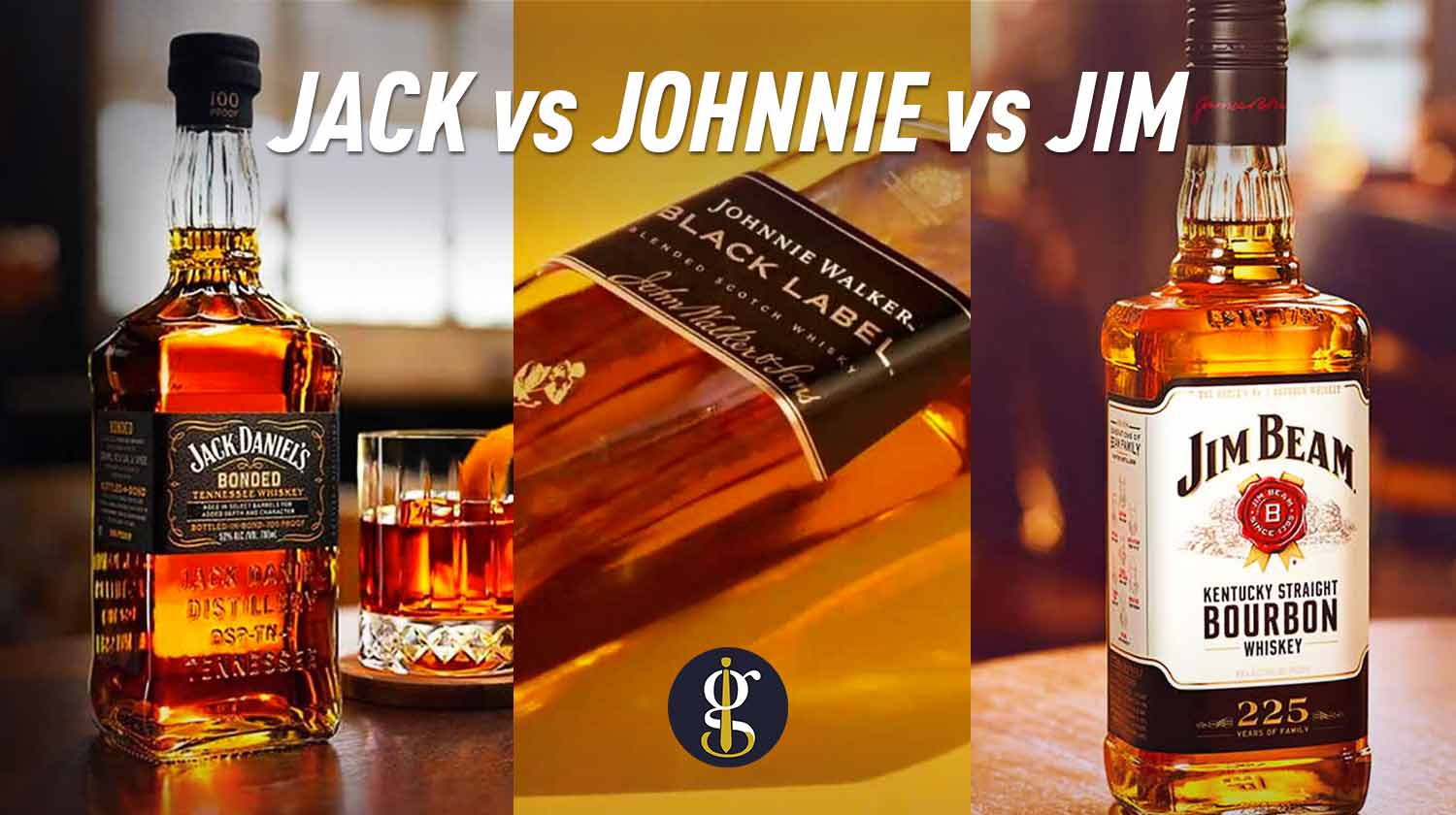
What do these three brands, each having a plethora of products, have in common and what sets them apart? Hopefully, this definitive guide will help you flesh out your understanding of these three iconic (and incredibly prolific) whiskies.
Jack vs. Jim vs. Johnnie (Best Whisky Battle)
First, however, we have to separate them into their categories. Both Jack Daniel’s and Jim Beam are produced not only in America, but in the traditional heartland of American whisky: Kentucky & Tennessee. They are also both bourbons which have certain production requirements, but in short: it must be aged in a barrel, 51% or more corn, and made in America.
Johnnie Walker, however, is a Scotch and is (perhaps obviously) made in Scotland and is instead made primarily from barley which is malted and heated over a peat fire. The production place, in terms of the water used in the locale, and the methods change the flavor for these three as much as the ingredients do. With this general breakdown, let’s examine the three in turn and then see how they compare and contrast…
…Starting with, none other than Jack Daniel’s.
All About Jack Daniel’s
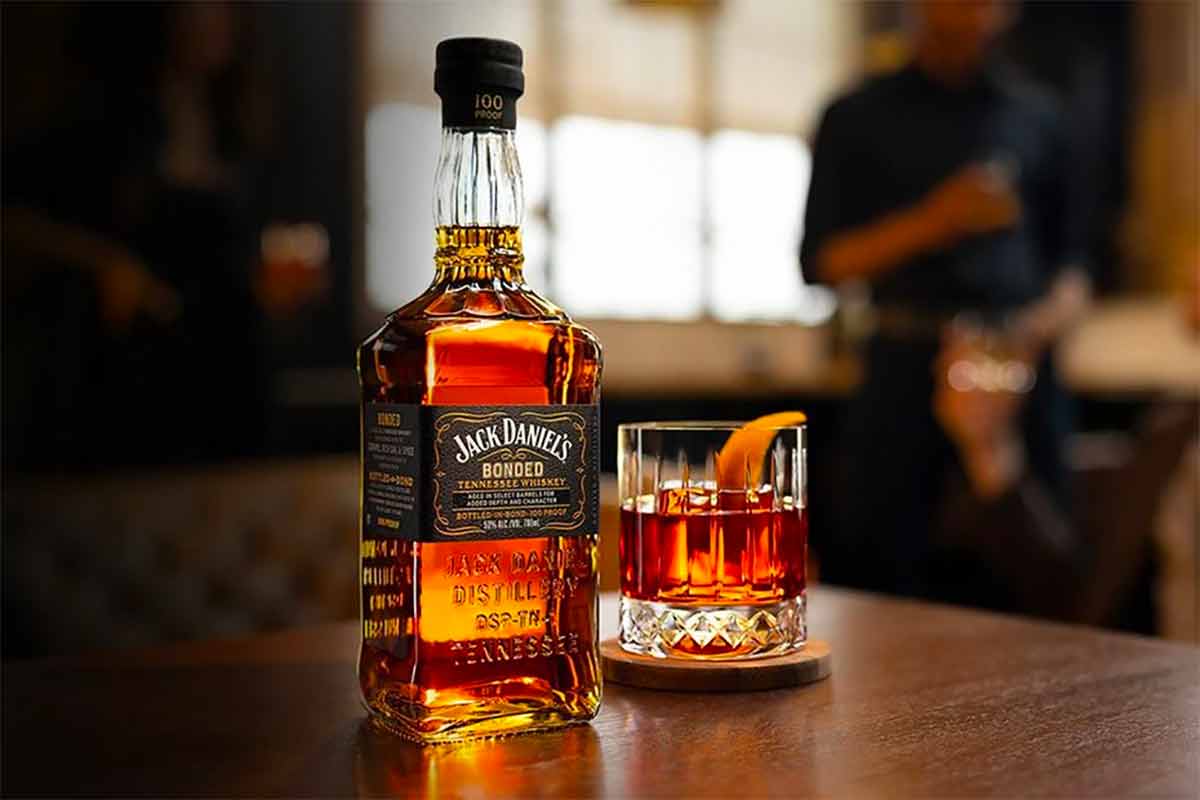
Jack Daniel’s is one of the most iconic and popular whiskies available almost anywhere in the world and is instantly recognizable by its square bottle (allegedly chosen by the creator to set it apart and signify that his customers were getting a “square deal”). It was founded in 1875 in Lynchburg, TN where it continues to be produced today.
In 1956 it was acquired by the Brown-Forman Corporation which also makes Old Forester, Woodford Reserve, Finlandia, and many other prominent liquors (they are based in Louisville, KY). The “mash” (composed of 80% corn, 12% rye, and 8% malted barley) is self-described as a “sour mash” which means that some of the wet solids from a previously used batch is added to each new production.
Having visited the distillery, I can tell you personally that the intense Jack Daniel’s-eque aroma this process gives off is both unforgettable and perfectly described as “sour. (this is in fact a very common process that almost all American whiskies use). Amusingly, Moore County where the distillery is located is a dry county, meaning it is illegal to purchase alcohol there – however, they have an exception through a state law.
A Lesser Known Origin Story
What is less known but is slowly being addressed is: Jack Daniel’s was created by an enslaved Black man: Nathan “Nearest” Green. Nearest mentored Daniel and was the foundational success behind the brand’s beginning.
This is finally entering the mainstream awareness as Brown-Forman Corporation (which owns Jack Daniel’s) acknowledged this in a statement by Matt Blevins, global brand director for Jack Daniel’s when he said, “The truth of the matter is, Nearest Green was the first head distiller of Jack Daniels whiskey.
We’re very proud of this story and are very committed to amplifying it and acknowledging that. In the past, we did not amplify it the way that we could have in earlier eras, but we’re about the future and moving forward.” So that’s a little progress at least.
It is believed that the unique flavor of Tennessee whiskey comes from a West African filtering process that was adapted to what Nearest (and his son, George who later worked there as well) had available in the area. You can read more about Nearest Green here: Enslaved Black Man Created World’s Most Popular Whiskey.
There is also now a distillery that was founded in 2017 to highlight his legacy which is incidentally also a tasty bourbon. For bonus points, this is a woman-run business (the first booze business with a woman at the head of it) and employs Nearest’s great-great-granddaughter Victoria Eady Butler as the master distiller. You can learn more here: Uncle Nearest.
» Related: You might like this article on the Best Bourbons Under $100.
Jack Daniel’s Products
Jack Daniel’s has a lengthy list of product offerings, but I’ll just cover the prominent ones and leave the special releases to your personal exploration. Old No. 7, or Black Label, is their iconic and most common offering. It has an unforgettable taste that is also very uniquely Jack Daniel’s which I always think of as musky, but in a good way.
It is also very very sweet which lends itself to being mixed with other things well. According to their website, in 1907, Dr. Lyman Kelber of the Bureau of Chemistry and Soils (long since reorganized) first mixed Jack Daniel’s with cola – the Jack and Coke was born.
In addition to their main offering, they also make a Tennessee Apple, Tennessee Honey, and Tennessee Fire flavored whiskies which are essentially the same base flavor with the addition of apple, honey, and cinnamon, respectively. They also produce a Rye (70% rye), Single Barrel which is unblended and bottled at a stronger proof, and “Gentleman Jack” which is their mellowed and smoother option if you find the Old No. 7 a bit abrasive.
What unites them all, however, is their unique, Tennessee whisky flavoring and bold intensity. Anyone who has tried Jack Daniel’s will not forget the flavor of Old No. 7 and its variants. What is helpful is that it is also relatively inexpensive, usually coming in around the $20s per bottle for the Old No. 7 (the variants cost more and can be quite premium).
Quick note: If you’re enjoying this guide on Jack Daniel’s vs Jim Beam vs Johnnie Walker, then you’ll probably find my other writing on all things style, self-development and mixology useful. Each week, I share style tips, inspiration, deals and other things not shared on the blog through my free email newsletter.
To join now, just enter your email address below and click “Get Updates!”
All About Jim Beam
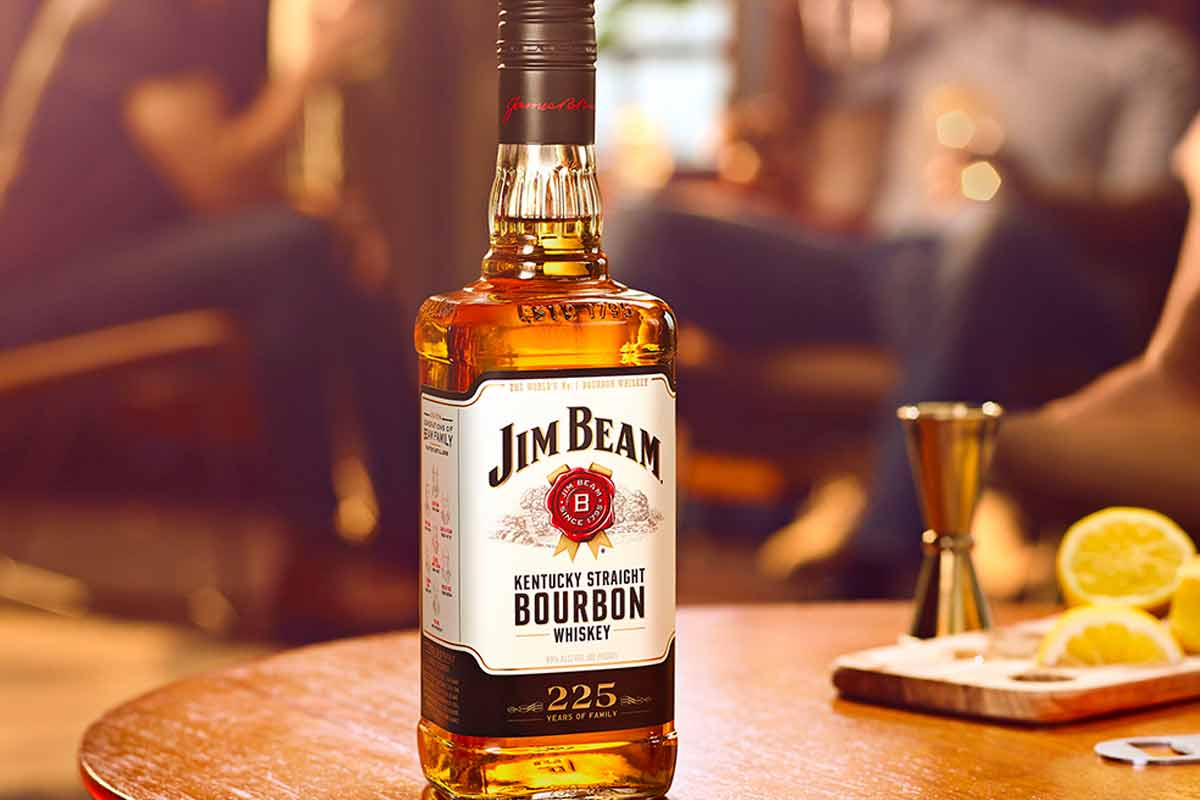
Turning now to Jack Daniel’s very close neighbor: Jim Beam. Jim Beam is one of the best selling bourbons in the world and has been being produced since 1795 (temporarily interrupted by Prohibition) and was purchased by Suntory in 2014 becoming Beam Suntory with its headquarters now in Chicago (they also produce Maker’s Mark, Basil Hayden’s, Knob Creek, Laphroaig, Courvoisier, and a number of other famous labels).
Their mash mixture is not on their website, but is at least 51% corn by law with rye and malted barley added. Fascinatingly, the yeast they use is the same strain since they resumed production after the end of Prohibition in 1933. This gives the product an unusually strong consistency across the decades.
Jim Beam also employs the sour mash process where they carry over the mix from one to the next to add even more consistency. In this way, the bourbon you might enjoy from them has a direct, actual biological link to the past, almost 100 years ago. Nothing like a bourbon with a bloodline!
» Related: Check out our list of The Best Bourbon Drinks.
Jim Beam Products
Similar to Jack Daniel’s, Jim Beam has a range of offerings but I’ll focus on what is available prominently. According to their website, the world’s #1 bourbon is their main offering, “Jim Beam Kentucky Straight Bourbon Whiskey.”
It is a lot less sweet than Old No. 7 and has a grain-like and oaky flavor, being aged for four years in American white oak barrels. It mixes pretty well and has a less pugnacious flavor than Old No. 7.
Jim Beam also produces a few “more refined” options such as their Single Barrel, Black, Double Oak, etc., on top of their flavored bourbons, such as Apple, Vanilla, Honey, Fire, etc. Some of their higher end options like the Single Barrel punch way above their weight and I always enjoy having them.
Their flavored bourbons are also, to me, the best flavored bourbons available. Like Old No. 7, their standard regular bourbon is pretty inexpensive and comes in closer to $15-20, which is also a helpful trait.
All About Johnnie Walker
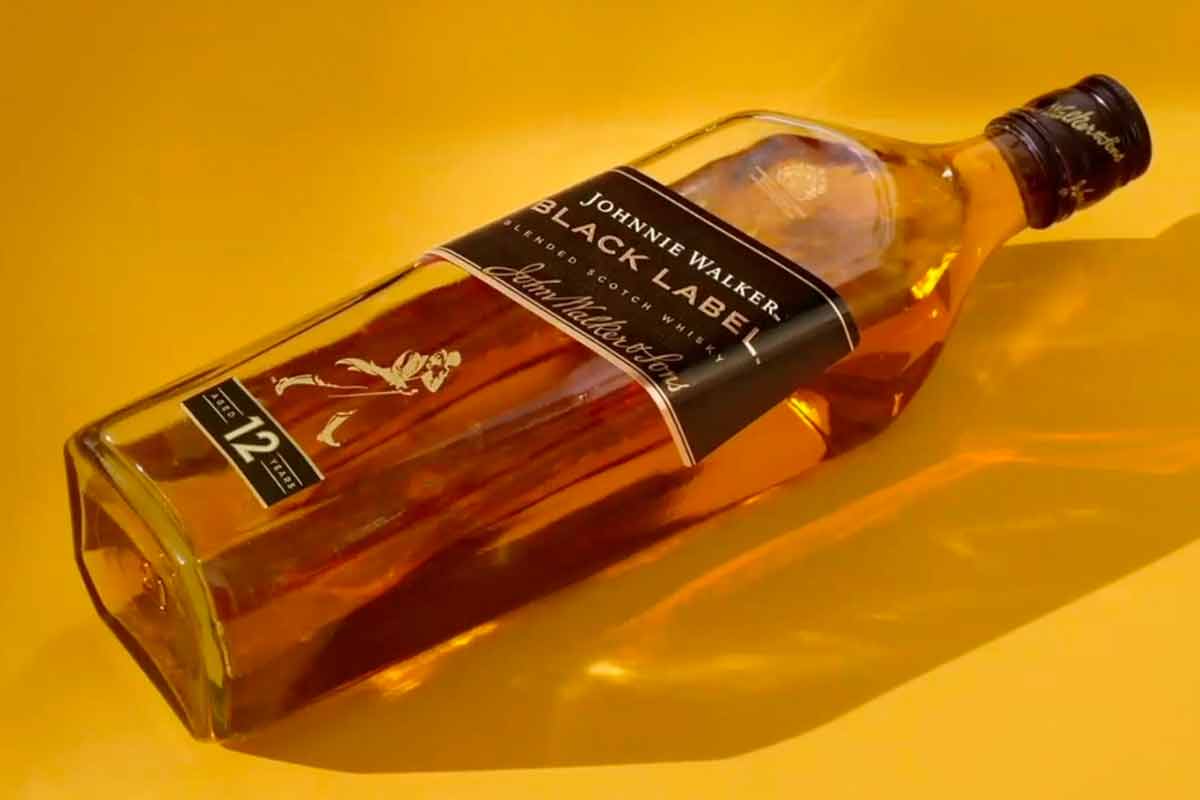
And finally, Johnnie Walker, the world’s most prominent Scotch. I was coincidentally drinking a glass of Johnnie Walker black the night before writing this article so it’s still very much on my mind, so to speak.
A Curious History
Curiously, Johnnie Walker began in 1820 in East Ayrshire, Scotland not as a whisky at all, but as a grocery store! It was named after the grocer himself, John Walker and remained an all purpose store, wine, and spirits shop for some decades (John Walker was himself a teetotaller but that clearly didn’t impact his desire to make money by selling the stuff!).
In 1823, the Excise Act relaxed the laws on the distillation of whisky and more importantly, really lowered the taxes on the distillation and sale (it is this author’s opinion that alarmingly many things boil down to decisions based on taxes). In just a few years, Mr. John Walker was selling whiskies from his shop that he would custom blend to his customer’s desires. At the time, he had no label or name of his own and wouldn’t for years but eventually landed on “Walker’s Kilmarnock Whisky” before dying in 1857.
In 1860, the Spirits Act legalized the blending of whisky and suddenly the world of drinking Scotch changed. Even still however, the name and core branding had not emerged. They would produce scotch under various names for years but always had the same label in different colors: white, red, and black. They became known colloquially by their color names and in 1909 the whisky was rebranded as Johnnie Walker White, Red, and Black respectively (white label was dropped during WWI).
At present, they are the world’s most widely distributed blended Scotch whisky in the world, sold in almost every country, and with an annual sales of over 223 million bottles.
Johnnie Walker Products
Like the others, I’ll focus on Johnnie Walker’s core range, already mentioned. Their foundational whisky is the Red Label, matured in oak casks for at least three years. Blended scotch’s aren’t listed by age in the same way single malts are since they often comprise whiskies from different ages to create the final product, so don’t pay too much attention to the age in this case.
They describe the red label as fiery or spicy and perfect for mixing – that should tell you what you need to know. If you want a backbone to a cocktail that is a little more spicy or smoky, add this to ginger ale / beer and enjoy a punchier version of a whisky ginger.
The other two major variants they stock are the black and blue labels (in ascending price from the red). The Black Label is smokey, some smooth carmelized vanilla, and a little more depth than the red, owing to its 12 year minimum aging. It is much like the red but smokier, and if I was to drink Johnnie Walker, this is my go to. Experienced drinkers of scotch might sometimes be bored by it as it doesn’t have layers of complexity that another, rarer scotch might have but it also never disappoints.
I should point out that the biggest difference between a single malt and a blend is that a single malt is produced to match a range of flavor that suits the brand but varies by the year, much like wine. A blend is tweaked every year to make the same flavor by changing the balance of the component parts. I leave it to you to decide which you enjoy, they’re all good to me!
The Blue Label is the top of the standard offerings (yes there are higher ones that are semi-common but that leaves the level of every-day drinking). For me, this is more money than it’s worth by about double, but owing to its popularity and cultural significance (people at large clubs and casinos enjoy showing off by buying bottles of this. These are the same people with enormous watches and offensively loud cars; more interested in the projection of wealth than having a quality product) I wanted to cover it, briefly.
It’s a lot smoother than the other ones owing to the more careful selection of what scotch they blend. You will get something on the same flavor profile as the other two, but with fewer spiky, harsh elements and more tongue-coating spice, caramel, chocolate, and, of course, smoke. This is probably the only one of the three I would drink neat, or possibly with a few droplets of water. If someone else is buying this for you, enjoy! If you feel tempted to waste money: don’t.
» Related: You might like this list of Best Gins Under $100 (For Gifting or Enjoying)
Whiskey Book Recommendations
- A Field Guide to Whisky: An Expert Compendium
- Whiskey Master Class: The Ultimate Guide
- The Bourbon Bible: The Complete Low-Down
- Bourbon: The Rise, Fall and Rebirth of an American Whiskey
- American History Through a Whiskey Glass
- Whiskey: A Tasting Course ( A new way to Think and Drink Whiskey)
- The World Atlas of Whisky
Wrapping Up
Hopefully this quick overview of “The Three J’s,” as absolutely no one calls them, helps you shop and order with confidence. You can find about any of them about any of the time in this country or abroad and relatively reasonable prices.
It’s always good to have a whisky or two at call in your back pocket since nothing, and I mean: nothing is as bad as being next to an experienced drinker (like your humble author) at the bar and wasting everyone’s time by not being ready.
While at the same time we all want you to have fun – so keep a few of these in your pocket so that when you’re under pressure and the overworked bartender looks to you, what you blurt out is something you will enjoy drinking and look good while doing so. As always, enjoy and just get out there and explore with abandon.
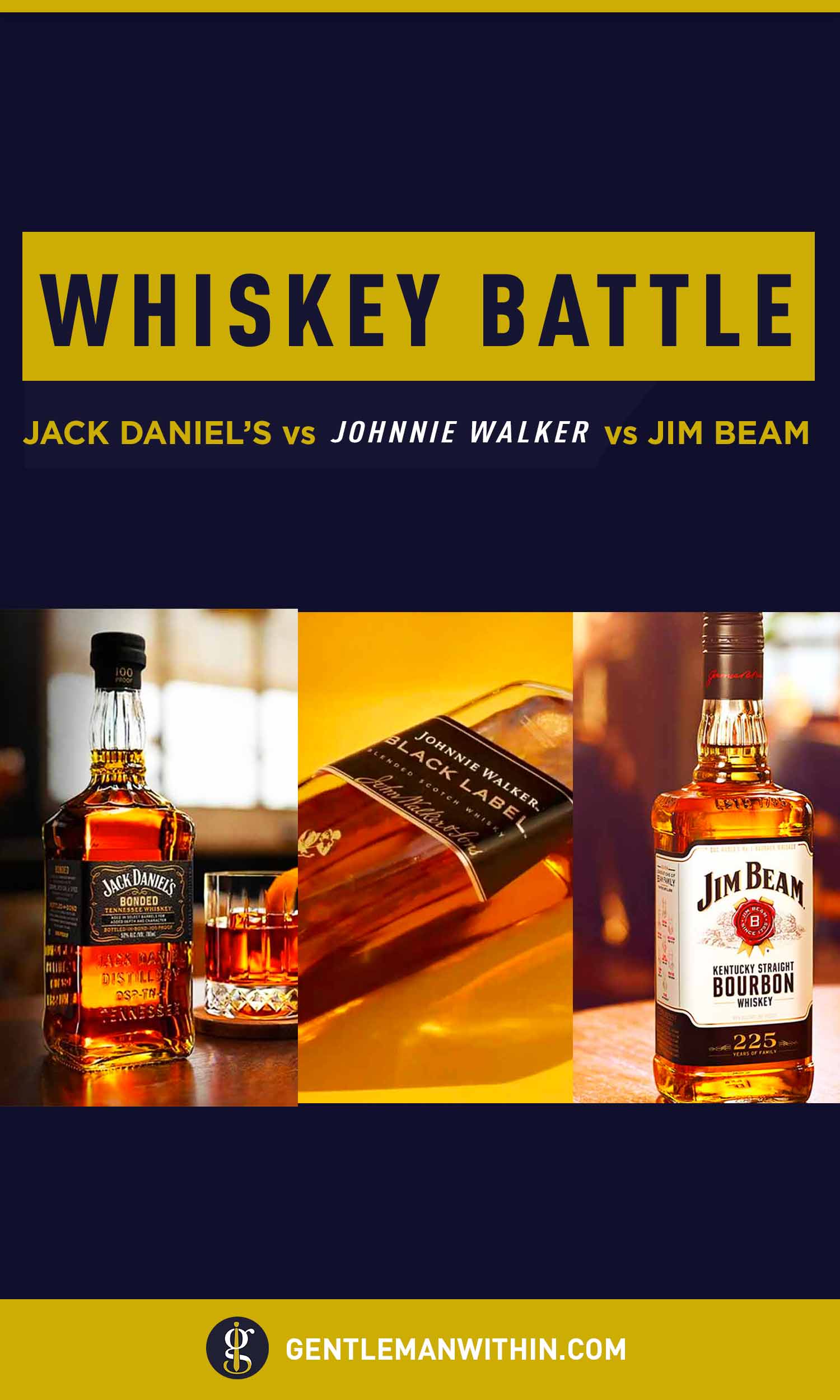
About Elijah

Elijah C. Mills is a native of Indiana, but now resides in Washington, D.C. A lover of all things ethanol and bow ties, you can find him out and about at various D.C. events. He is an active Episcopalian and works as a Parish Administrator at a DC Episcopal church. He’s always happy to meet over a drink and can be easily talked into most social events.
Jack Daniel’s, Jim Beam or Johnnie Walker, who ya got?
Let’s continue the discussion over in the Gentlemen Within Private Facebook Community. Looking forward to seeing you in there.
LIKE WHAT YOU READ?
Get more posts like this plus style tips & advice delivered straight to your inbox.

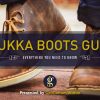




Drop a Line!